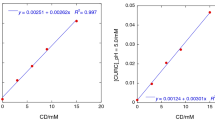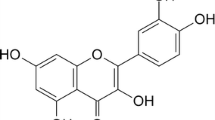Abstract
Quercetin (QCT), a flavonoid derived from many fruits and vegetables, is endowed with manifold biological properties, such as the ability to elicit a strong inhibitory effect on the growth of several tumor cell lines. Unfortunately, the pharmacological application of QCT is severely restricted by its inherent hydrophobicity and consequent low in vivo bioavailability. The therapeutic potential of QCT can be unraveled by enhancing its solubility through the formation of a host–guest complex with hydroxypropyl-β-cyclodextrin (HPβCD). In this study, HPβCD·QCT complex has been obtained in liquid phase, at 37 °C and under a prolonged mixing (72 h), and using two buffers at pH = 3.6 and pH = 8.0. Phase solubility and differential scanning calorimetry (DSC) studies revealed that, at pH = 8.0, the complex was obtained with a 1:1 stoichiometric ratio and a strong enhancement of QCT solubility, while in acidic buffer complex formation was significantly thwarted. The affinity constant was calculated by isothermal calorimetry at pH = 8 and was found to be 489 ± 38 M−1, in good agreement with the value indirectly obtained from phase solubility tests 394 ± 101 M−1. The results confirmed the formation of the inclusion complex between QCT and HPβCD and highlight the importance of the choice of the appropriate solvent, pH, temperature and mixing time on the formation of host guest inclusion complex with active ingredient(s) and HPβCD.



Similar content being viewed by others
References
Apak R, Guclu K, Demirata B, Ozyurek M, Celik SE, Bektasoglu B, Berker KI, Ozyurt D. Comparative evaluation of various total antioxidant capacity assays applied to phenolic compounds with the CUPRAC assay. Molecules. 2007;12:1496–547.
Keli SO, Hertog MG, Feskens EJ, Kromhout D. Dietary flavonoids, antioxidant vitamins, and incidence of stroke: the Zutphen study. Arch Intern Med. 1996;156:637–42.
Zhang Y, Yang F, Jamali MA, Peng Z. Antioxidant enzyme activities and lipid oxidation in rape (Brassica campestris L.) bee pollen added to salami during processing. Molecules. 2016;21:1439–52.
Formica JV, Regelson W. Review of the biology of Quercetin and related bioflavonoids. Food Chem Toxicol. 1995;33:1061–80.
Ohnishi E, Bannai H. Quercetin potentiates TNF-induced antiviral activity. Antiviral Res. 1993;22:327–31.
Guardia T, Rotelli AE, Juarez AO, Pelzer LE. Anti-inflammatory properties of plant flavonoids. Effects of rutin, quercetin and hesperidin on adjuvant arthritis in rat. Farmaco. 2001;56:683–7.
Khonkarn R, Mankhetkorn S, Hennink WE, Okonogi S. PEG-OCL micelles for quercetin solubilization and inhibition of cancer cell growth. Eur J Pharm Biopharm. 2011;79:268–75.
Ghasemzadeh A, Jaafar HZ, Rahmat A, Ashkani S. Secondary metabolites constituents and antioxidant, anticancer and antibacterial activities of Etlingera elatior (Jack) RM Sm grown in different locations of Malaysia. BMC Complement Altern Med. 2015;15:335–45.
Scambia G, Ranelletti FO, Panici PB, Piantelli M, Bonanno G, De VR, Ferrandina G, Rumi C, Larocca LM, Mancuso S. Inhibitory effect of quercetin on OVCA 433 cells and presence of type II oestrogen binding sites in primary ovarian tumours and cultured cells. Br J Cancer. 1990;62:942–6.
Larocca LM, Piantelli M, Leone G, Sica S, Teofili L, Panici PB, Scambia G, Mancuso S, Capelli A, Ranelletti FO. Type II oestrogen binding sites in acute lymphoid and myeloid leukaemias: growth inhibitory effect of oestrogen and flavonoids. Br J Haematol. 1990;75:489–95.
Murugan C, Rayappan K, Thangam R, Bhanumathi R, Shanthi K, Vivek R, Thirumurugan R, Bhattacharyya A, Sivasubramanian S, Gunasekaran P, Kannan S. Combinatorial nanocarrier based drug delivery approach for amalgamation of anti-tumor agents in bresat cancer cells: an improved nanomedicine strategies. Sci Rep. 2016;6:34053–70.
Demiroglu-Zergeroglu A, Ergene E, Ayvali N, Kuete V, Sivas H. Quercetin and Cisplatin combined treatment altered cell cycle and mitogen activated protein kinase expressions in malignant mesotelioma cells. BMC Complement Altern Med. 2016;16:281–7.
Wang C, Su L, Wu C, Wu J, Zhu C, Yuan G. RGD peptide targeted lipid-coated nanoparticles for combinatorial delivery of sorafenib and quercetin against hepatocellular carcinoma. Drug Dev Ind Pharm. 2016;42:1938–44.
Malik A, Sultana M, Qazi A, Qazi MH, Parveen G, Waquar S, Ashraf AB, Rasool M. Role of natural radiosensitizers and cancer cell radioresistance: an update. Anal Cell Pathol (Amst). 2016;2016:6146595–603.
Moyano-Mendez JR, Fabbrocini G, De SD, Mazzella C, Mayol L, Scognamiglio I, Carnuccio R, Ayala F, La Rotonda MI, De RG. Enhanced antioxidant effect of trans-resveratrol: potential of binary systems with polyethylene glycol and cyclodextrin. Drug Dev Ind Pharm. 2014;40:1300–7.
Miro A, d’Angelo I, Nappi A, La MP, Biondi M, Mayol L, Musto P, Russo R, La Rotonda MI, Ungaro F, Quaglia F. Engineering poly(ethylene oxide) buccal films with cyclodextrin: a novel role for an old excipient? Int J Pharm. 2013;452:283–91.
Mayol L, Serri C, Menale C, Crispi S, Piccolo MT, Mita L, Giarra S, Forte M, Saija A, Biondi M, Mita DG. Curcumin loaded PLGA-poloxamer blend nanoparticles induce cell cycle arrest in mesothelioma cells. Eur J Pharm Biopharm. 2015;93:37–45.
Szejtli J. Introduction and general overview of cyclodextrin chemistry. Chem Rev. 1998;98:1743–54.
Corrigan OI, Stanley CT. Mechanism of drug dissolution rate enhancement from beta-cyclodextrin-drug systems. J Pharm Pharmacol. 1982;34:621–6.
Brewster ME, Loftsson T. Cyclodextrins as pharmaceutical solubilizers. Adv Drug Deliv Rev. 2007;59:645–66.
Stella VJ, Rajewski RA. Cyclodextrins: their future in drug formulation and delivery. Pharm Res. 1997;14:556–67.
Gladys G, Claudia G, Marcela L. The effect of pH and triethanolamine on sulfisoxazole complexation with hydroxypropyl-beta-cyclodextrin. Eur J Pharm Sci. 2003;20:285–93.
Liu M, Dong L, Chen A, Zheng Y, Sun D, Wang X, Wang B. Inclusion complexes of quercetin with three beta-cyclodextrins derivatives at physiological pH: spectroscopic study and antioxidant activity. Spectrochim Acta A Mol Biomol Spectrosc. 2013;115:854–60.
Jullian C, Moyano L, Yanez C, Olea-Azar C. Complexation of quercetin with three kinds of cyclodextrins: an antioxidant study. Spectrochim Acta A Mol Biomol Spectrosc. 2007;67:230–4.
Pralhad T, Rajendrakumar K. Study of freeze-dried quercetin-cyclodextrin binary systems by DSC, FT-IR, X-ray diffraction and SEM analysis. J Pharm Biomed Anal. 2004;34:333–9.
Author information
Authors and Affiliations
Corresponding author
Rights and permissions
About this article
Cite this article
D’Aria, F., Serri, C., Niccoli, M. et al. Host–guest inclusion complex of quercetin and hydroxypropyl-β-cyclodextrin. J Therm Anal Calorim 130, 451–456 (2017). https://doi.org/10.1007/s10973-017-6135-5
Received:
Accepted:
Published:
Issue Date:
DOI: https://doi.org/10.1007/s10973-017-6135-5




